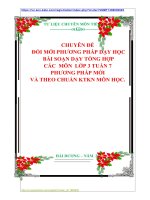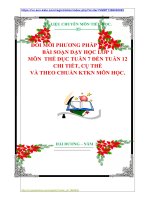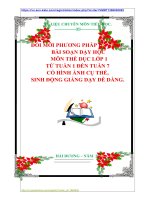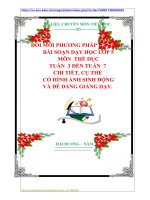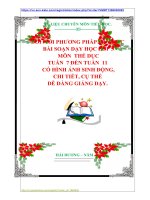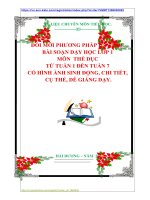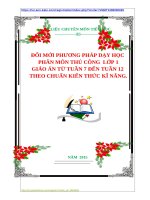Ta8 tuan 7 p19,20,21 (1)
Bạn đang xem bản rút gọn của tài liệu. Xem và tải ngay bản đầy đủ của tài liệu tại đây (151.75 KB, 10 trang )
<span class="text_page_counter">Trang 1</span><div class="page_container" data-page="1">
<b>1. Knowledge: By the end of the lesson, students will be able to use the lexical items</b>
related to cultural groups of Viet Nam to talk together. - Vocabulary: relating to ethnic groups of Viet Nam. - Grammar: Question words, articles a/ an/ the.
<b>2. Competence: Group work, individual work, pair work, linguistic competence,</b>
cooperative learning and communicative competence.
<b>3. Behavior: Students have good attitude towards customs of the peoples of Viet Nam.</b>
They can communicate together through a quiz about ethnic groups of Viet Nam.
<b> . Teaching aids:</b>
<b>1. Teacher: Textbooks, teaching plan, teacher’s book…2. Students: Textbooks, notebooks…</b>
<i><b>a, Aim: To warm up the class and lead in the lesson.</b></i>
<i><b>b, Contents: Ss work individually to insert a, an, the in each gap to finish the passage.c, Outcome: Ss can use articles in real context correctly.</b></i>
<i><b>d, Organization:</b></i>
- T puts questions for ss to answer. Ss work in pairs to answer the questions.
<i>+ Can you tell me something about ethnicgroups of Viet Nam? </i>
<i>+ Can you give the names of some ethnicgroups of Viet Nam?</i>
<i>+ Where is each place located?</i>
- T leads ss to the new lesson:
<i>+ There are many other ethnic groups of</i>
<b>Chatting</b>
</div><span class="text_page_counter">Trang 2</span><div class="page_container" data-page="2"><i>Viet Nam which you haven’t known about.You will broaden your mind about thatafter our lesson today.</i>
<i>+ We are going to explore some ethnic</i>
<i>groups of Viet Nam in this lesson.</i>
<b>2. Presentation (10’)</b>
<i><b>a, Aim: Help students know about the ethnic groups of Viet Nam.b, Contents: Ss work in pairs to do the quiz.</b></i>
<i><b>c, Outcome: Ss can know about the ethnic groups of Viet Nam well.d, Organization: </b></i>
- Asks ss to work Ss work in pairs to do the quiz.
- Ss work in pairs to do the quiz. Then Ss give the answers.
- T checks and gives explanation.
<b>Quiz: What do you know about the ethnicgroups of Viet Nam</b>
<b>=> Key: </b>
<i>1. B 2. A 3. C 4. B 5. C 6. A</i>
<b>3. Practice (10’)</b>
<i><b>a, Aim: Help students know more about the ethnic groups of Viet Nam.b, Contents: Ss work in pairs to do the quiz.</b></i>
<i><b>c, Outcome: Ss can know more about the ethnic groups of Viet Nam well.d, Organization:</b></i>
- T asks Ss work in groups. - Ss work in groups to discuss.
- T lets Ss discuss and then write down the ethnic groups in the correct boxes. Ss do it. - T encourages Ss to add other ethnic groups they know of to the list. Ss do it. - T moves around the groups and gives assistance where needed.
<b>2. Where do these ethnic groups mainlylive? </b>
<i>+ Northwest region: Viet, Hmong, Lao</i>
<i>+ Northeast region: Viet, Hmong, Nung, Tay+ The central Highlands: Viet, Bahnar,Brau, Ede, Giarai, Sedang</i>
<i>+ Mekong River Delta: Viet, Cham, Khmer+ Red River Delta: Viet</i>
<b>4. Application (13’)</b>
<i><b>a, Aim: Help students talk about the ethnic groups of Viet Nam.</b></i>
<i><b>b, Contents: Ss work in groups to talk about the ethnic groups of Viet Nam.c, Outcome: Ss can talk about the ethnic groups of Viet Nam well.</b></i>
</div><span class="text_page_counter">Trang 3</span><div class="page_container" data-page="3"><i><b>d, Organization: </b></i>
- T divides the class into 4 groups. Each group talk about an ethnic group (Tay, Dao, Mong, Nung)
- Talk about in relation to these groups.
<i>Elicit these subjects if possible: (location </i>
<i>-lifestyle – costumes - foods - festivals/ceremonies - marriage/ weddings …)</i>
- Give Ss time to prepare, and then let them talk in groups.
- T gives comments and feedback.
<b>3. Talk about the ethnic groups of Viet</b>
- Asks ss to sum up the main content of the lesson
- Consolidates more about the main content of the lesson.
<b>* Homework: Asks Ss to:</b>
+ Learn by heart all the new words and structures. + Do exercises: A, B (Work book).
<i><b>+ Prepare: Unit 3 - Skills 1.</b></i>
BGH ký duyệt ngày …. Tháng 10 năm 2022
<b>P. Hiệu Trưởng</b>
<b>Nguyễn Thị Ngọc</b>
</div><span class="text_page_counter">Trang 4</span><div class="page_container" data-page="4"><b>Week 7 - Period 20</b>
<i>Date of planning: October 16<small>th</small>, 2022</i>
<b>UNIT 3: PEOPLES OF VIETNAMLesson 5: Skills 1</b>
<b>A. Objectives </b>
<b>1. Knowledge: By the end of the lesson, students will be able to understand the content of</b>
<b>the life of ethnic groups.</b>
- Vocabulary: life of ethnic group lexical items. - Grammar: Question words, articles: a, an, the.
<b>2. Competence: Group work, individual work, pair work, linguistic competence,</b>
cooperative learning and communicative competence.
<b>3. Behavior: Students have good attitude towards customs of the peoples of Viet Nam.</b>
They can be aware of responsibilities with ethnic groups of Viet Nam.
<b> . Teaching aids:</b>
<b>1. Teacher: Textbooks, teaching plan, teacher’s book…2. Students: Textbooks, notebooks…</b>
<i><b>a, Aim: To warm up the class and lead in the lesson.</b></i>
<i><b>b, Contents: Ss work individually to tell what they know about the Thai.c, Outcome: Ss can talk about the Thai as much as they can.</b></i>
<i><b>d, Organization:</b></i>
- T shows Ss some pictures of the Thai and
<i>writes the word “Thai” on the board. </i>
- T has Ss brainstorm what they know about
<i>this country and its people (they can express</i>
<i>in Vietnamese some words that they can’texpress in English). Ss work individually.</i>
- Keeps it to the end of the period. - T introduces the new lesson.
<i>stilt house</i>
<i>traditional costumes/ dances</i>
<b>2. Presentation (6’)</b>
</div><span class="text_page_counter">Trang 5</span><div class="page_container" data-page="5"><i><b>a, Aim: Help Ss study some vocabularies related to the topic.b, Contents: Ss work individually to study the vocabularies.</b></i>
<i><b>c, Outcome: Ss can know more vocabularies related to the topic “Peoples of Viet Nam”.d, Organization:</b></i>
- T uses different techniques to teach vocabulary and follows seven steps of teaching vocabulary.
- Ss listen carefully the T’s modeling twice, repeat in chorus and individually and copy all the words.
<b>=> Checking: Matching</b>
<i>+ dig (v): đào</i>
<i> + canal (n): con kênh </i>
<i>+ burnt- out land: đất sau khi đốt cỏ cây </i>
<i><b>a, Aim: Help students understand the reading passage by doing reading exercises and talk </b></i>
about one ethnic group.
<i><b>b, Contents: </b></i>
<b>+ Ss work individually to answer the questions.</b>
+ Ss work individually to complete each sentence, using a word from the text. + Ss work in pairs to answer the questions.
+ Ss work in groups to read some facts about the Bru-Van Kieu people and the Khmer people. Then choose one of the two ethnic groups and talk about it.
<i><b>c, Outcome: Ss can do reading exercises correctly and they can talk about one ethnic</b></i>
group well.
<i><b>d, Organization:</b></i>
- T tells Ss that they are going to read a text
<i>about The Thai. T gives Ss time to answer the</i>
two questions by themselves. T encourages Ss to make guesses if they are not sure.
- Ss work individually to answer the
<i>1. The Thai live in the provinces of LaiChau, Son La, Yen Bai, Hoa Binh, ThanhHoa and Nghe An.</i>
<i>2. The Thai have a population of aboutone and a half million people.</i>
</div><span class="text_page_counter">Trang 6</span><div class="page_container" data-page="6">- T checks and corrects as a class.
- T asks Ss to read the passage again and do the task. Ss work individually to do the task. - T checks the answers as a class.
- T asks Ss to read the passage again and answer the questions.
- Ss can ask and answer in pairs. - T checks the answers as a class.
- T divides the class into two groups. Each group prepares to talk about one ethnic group.
- Ss work in groups to discuss about one ethnic group.
- T goes around to assist if necessary. Then ask some volunteers to present to the rest of the class.
<b>2. Complete each sentence, using aword from the text.</b>
<i>1. Yes, they do.</i>
<i>2. Their main food is rice.</i>
<i>3. It is well-known for being unique,colorful and strong. </i>
<i>4.Thai women do.</i>
<i>5. They worship their ancestors.</i>
<b>II. Speaking</b>
<b>4. Read some facts about the Bru-VanKieu people and the Khmer people.</b>
<b>Work in groups. Choose one of the twoethnic groups and talk about it.</b>
<b>4. Application (7’)</b>
<i><b>a, Aim: Help students talk about their own ethnic group.b, Contents: </b></i>
<b>+ Ss work individually to answer the questions.</b>
+ Ss work individually to complete each sentence, using a word from the text. + Ss work in pairs to answer the questions.
+ Ss work in groups to read some facts about the Bru-Van Kieu people and the Khmer people. Then choose one of the two ethnic groups and talk about it.
<i><b>c, Outcome: Ss can talk about their own ethnic group well.d, Organization:</b></i>
<b>- T lets Ss talk about their own ethnic group. 5. Talk about YOUR own ethnic</b>
</div><span class="text_page_counter">Trang 7</span><div class="page_container" data-page="7">T asks Ss to focus on one or two aspects such
<i>as clothing, food, ways of living, customs and</i>
<i>traditions, festivals, beliefs, etc. </i>
- T encourages Ss to talk about changes in the life of their people over time.
- Ss work individually to talk about their own
- Asks ss to sum up the main content of the lesson
- Consolidates more about the main content of the lesson.
<b>* Homework: Asks Ss to:</b>
+ Learn by heart all the new words and structures. + Do exercises (Work book).
<i><b>+ Prepare: Unit 3-Skills 2.</b></i>
</div><span class="text_page_counter">Trang 8</span><div class="page_container" data-page="8"><b>A. Objectives </b>
<b>1. Knowledge: By the end of the lesson, students will be able to know more about some</b>
traditional food and drink of ethnic groups.
<b>- Vocabulary: Vocabulary about a traditional dishes.</b>
<i>- Grammar: Question words, articles: a/ an/ the.</i>
<b>2. Competence: individual work, pair work, linguistic competence, cooperative learning</b>
and communicative competence.
<b>3. Behavior: Students have good attitude towards customs of the peoples of Viet Nam.</b>
They can listen to get specific information about a traditional dish and write the recipe for a traditional dish.
<b> . Teaching aids:</b>
<b>1. Teacher: Textbooks, teaching plan, teacher’s book…2. Students: Textbooks, notebooks…</b>
<i><b>a, Aim: To warm up the class and lead in the lesson.b, Contents: Ss work in pairs to discuss two questions.c, Outcome: Ss can answer two questions well.</b></i>
<i><b>d, Organization:</b></i>
- T asks Ss to discuss the two questions in pairs. Then tell Ss to look at the picture and say what they know about that dish.
- Ss discuss the questions in pairs and give results.
<b>1. Answer the questions:</b>
<i>1. Do you like sticky rice?</i>
<i>2. When do we traditionally have stickyrice?</i>
<b>- 2. Presentation (5’)</b>
<i><b>a, Aim: Help Ss study some vocabularies related to the topic.b, Contents: Ss work individually to study the vocabularies.</b></i>
<i><b>c, Outcome: Ss can know more vocabularies related to the topic “Peoples of Viet Nam”.d, Organization:</b></i>
<b>- T uses different techniques to teach Vocabulary:</b>
</div><span class="text_page_counter">Trang 9</span><div class="page_container" data-page="9">vocabulary and follows seven steps of teaching vocabulary.
- Ss listen carefully the T’s modeling twice, repeat in chorus and individually and copy all the words.
<b>=> Checking: Slap the board.</b>
<i><b>a, Aim: Help students listen to a text about a traditional dish and know how to write a</b></i>
paragraph about how to make yellow sticky rice.
<i><b>b, Contents: </b></i>
<b>+ Ss work individually to listen to the passage and tick true (T) or false (F).</b>
+ Ss work individually to listen again and complete the sentences.
+ Ss work individually to read a note on how to make yellow sticky rice.
<i><b>c, Outcome: Ss can understand the listening text by doing listening exercises correctly</b></i>
and they know how to write a paragraph about how to make yellow sticky rice well.
<i><b>d, Organization: </b></i>
- T plays the recording once or twice. Ask Ss to listen carefully and tick True or False according to what they hear in the passage. - Ss work individually. T corrects and remarks
- T plays the recording again and asks Ss work individually to do the task.
- Ss write down the words as they listen. T plays the recording again for them to check.
- Tells Ss to read the notes carefully. - Ss work individually to read the note.
- T has Ss write full sentences to show the steps to cook the rice. Make sure that they use proper connectors first/ firstly, second/ <i>3.natural 4. plants 5. ceremonies</i>
<b>4. Read a note on how to make yellowsticky rice</b>
</div><span class="text_page_counter">Trang 10</span><div class="page_container" data-page="10">secondly, … and pay attention to spelling and punctuation.
<b>4. Application (8’)</b>
<i><b>a, Aim: Help students write how to make yellow sticky rice.</b></i>
<i><b>b, Contents: Ss work individually to write how to make yellow sticky rice.c, Outcome: Ss can write a paragraph about how to make yellow sticky rice well.d, Organization:</b></i>
- T ask Ss to write a paragraph (in the form of a letter to a pen friend, for example). T may collect some Ss’ writing papers and mark them, then give comments to the class.
- T may ask Ss to write a paragraph as homework (in the form of a letter to a pen friend, for example) if there isn’t enough time.
<b>5. Change the notes into cooking steps toshow a foreign visitor how to makeyellow sticky rice.</b>
<i>This delicious dish is really easy to make.First, you need to soak the rice in water for atleast five hours. Then rinse the rice and drainit well. Next, add the turmeric extract and mixit well. Then wait for 10 minutes. After that,add the coconut and salt. Remember to mix itwell. Finally, steam the rice for 30 minutes.Check that it is fully cooked. You can servethis dish with chicken.</i>
<b>3. Consolidation and guides for homework (2’)* Consolidation:</b>
- Asks ss to sum up the main content of the lesson
- Consolidates more about the main content of the lesson.
<b>* Homework: Asks Ss to:</b>
<b>+ Learn by heart vocabulary and structures.</b>
+ Complete the paragraph at home. + Do exercises of Unit 3 in workbook.
<i><b>+ Prepare Unit 3 - Looking back + Project.</b></i>
</div>
